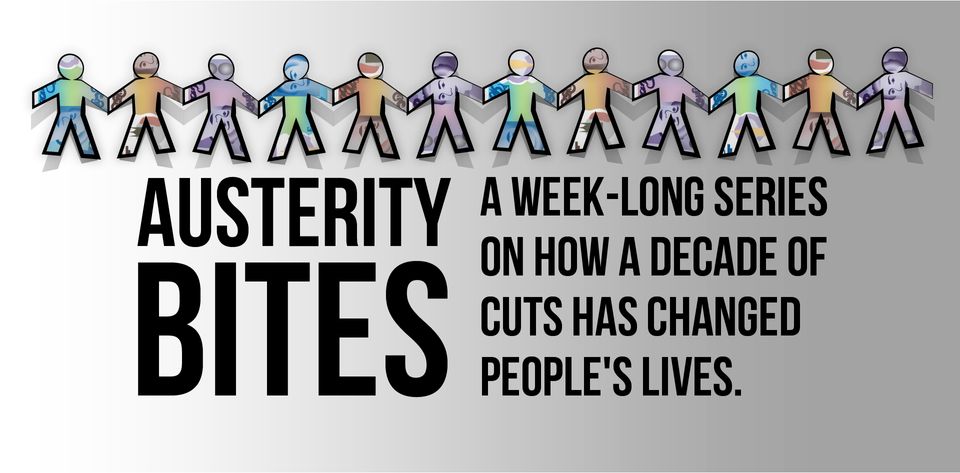
After a decade of expanding public budgets under the Labour government, the first austerity cuts introduced by the Tory-Liberal Democrat Coalition in 2010 seemed unpalatable, but not necessarily devastating.
Police forces were cut; Sure Start, set up to help infants from disadvantaged backgrounds, was pared back – but the shrinking budgets were, while painful, manageable.
Now, the years have ticked on. We are eight years into austerity budget cuts, and critics now say we’re in a spiral: services have been stripped of cash, budgets are slashed, struggling families cannot get the help they need prompting costly interventions, and then yet more services are cut.
And in recent months, the effects of this has been hitting headlines: from collapsing local government services, crises in prisons and the under-funded courts system, and major squeezes to the income of families (often working families) reliant on benefits and tax credits to make ends meet.
For the shadow local government secretary, Andrew Gwynne, the situation is clear: “Cuts have consequences,” he says. “Early cuts have led to a higher cost to the public purse, shunting costs around, and to more human misery.”
Austerity has been the flagship policy of the Conservative party for eight years – a project sold to the country as a desperate measure to fix out-of-control spending, fuelled also by an ideological desire to shrink the size of the state.
It is a policy kick-started by the coalition government in 2010 under David Cameron and George Osborne, and continued by Theresa May’s government despite early pledges to end the “burning injustices” in British society, even as her chancellor vows to keep controls on spending.
But as it fails on its own terms – deep cuts to services, the state hasn’t shrunk – and the country’s balance sheet faces being blown up anew by Brexit, the open question remains how much longer can austerity continue, and what can replace it?

There is no doubt the cuts are starting to bite. In local government, Conservative-controlled Northamptonshire council has been declared effectively bankrupt, and a damning report released last month by the Public Accounts Committee warns councils – which control social care for children, working-age, and elderly adults, as well as libraries, rubbish, and other services – face a £5 billion shortfall by 2020, which could lead to other councils going bust in years to come.
“And of course, often the agencies which would have stepped in to help those affected aren’t there – whether the police, local authorities or even grant funded organisations like the Citizens’ Advice Bureau can’t pick up the extra load as they’ve had cuts of their own.”
Analysis by the prestigious Institute for Fiscal Studies and shared with HuffPost UK estimates the cuts to local government to date amount to around 24% of total spending, with the legal requirement to provide social care meaning that other services have faced even larger cuts.
The number of older adults receiving care has dropped by around a fifth
In real terms, that amounts to around £12bn since 2009/10 – roughly equivalent to the total amount councils were spending on child social care, libraries and waste collection and disposal combined in that year, a vast cut for councils to absorb and one which has disproportionately hit poorer areas, which are more reliant on central government for their funding.
Official figures suggest that even in protected areas such as social care, councils are having to take drastic measures to make ends meet – so even though the UK has an ageing and increasingly frail population, the number of older adults receiving care has dropped by around a fifth.
This is due to councils tightening the criteria to receive help, meaning older adults have to have more severe needs before receiving support – which in turn means each person costs more once they are eligible for help.

Cuts and painful choices like this have occurred across the country – and there are far more to come, with perhaps the most difficult lying ahead. “Cutting spending becomes harder the longer you do it for, and actually the first few years proved easier than I think most people expected,” says IFC director Paul Johnson. “But for a lot of services, some starting in 2014, some more recently, you get to a point where it’s very hard to make more cuts without having a severe effect.”
The government signaled plans to increase NHS spending by £20bn over the next six years – a figure which not-entirely-coincidentally amounts to £350million-a-week – but chancellor Philip Hammond has warned this does not signal an end to cuts in other departments, and has not yet revealed how the substantial spending will be paid for.
“£20bn on health is 1% of national income, and yet over five years represents health spending growing possibly less than its average over the last 70 years,” Johnson explains. “1% of national income extra is substantial extra spending, but health is so big that it’s not huge by any means.”
Austerity was not dreamed up overnight. It was sold in the aftermath of the global financial crisis as necessary belt-tightening after years of Labour overspending
The bigger headaches come when austerity is combined with stagnant UK wages since the UK financial crisis. In the public sector, this has been felt in pay freezes or rises capped at 1% (less than inflation, meaning it’s a cut in real terms) for several years – but workers in the private sector have seen similar real-terms cuts, leaving many financially precarious.
For those on lower- and middle-incomes, this was heightened by a working-age benefits freeze, meaning a double whammy on family finances – a lower salary and a lower top-up. While the government has promised modest increases in public sector wages, its financial targets suggest it will not increase overall spending, meaning austerity definitely isn’t over yet.

MPs are often faced with those feeling those consequences. Despite being the MP for a constituency in a relatively well-off area – Oxford West and Abingdon – Liberal Democrat MP Layla Moran and her team are often faced with people struggling to get by or to secure vital services.
The problems people most commonly face, one of her team explains, are troubles with universal credit or housing benefit, which due to its new cap often fails to cover the high rents prevailing in Oxford – social rent is defined as 80% of “market rate”, meaning it’s often still nowhere near affordable. Elsewhere, families struggle to secure help in schools for their children with special educational needs, simply because the council can’t afford to provide it – with similar challenges facing access to child mental health services.
There is also, according to the IFS’ Paul Johnson, no imminent prospect of relief from this situation if the government sticks to its plans. “Actual real day to day spending is at best not going to rise over the next 3-4 years on that basis, and if you think of austerity as spending falling as national income, that’s an additional period of austerity,” he says. “That relates to the fact the government still wants to get to a balanced budget. Whether that’s what they’ll actually do I don’t know.”
But austerity has not been a policy which was dreamed up overnight. When introduced in the aftermath of the global financial crisis, it was sold to the public as necessary belt-tightening after years of Labour overspending – despite Conservatives just months before pledging to match that overall spending.
In reality, austerity was an ideologically-driven policy to restore government spending to pre-crisis levels – the government response to the crisis boosted spending – and to try to keep credibility on UK government finances.
Austerity has largely failed in reducing government spending as a percentage of the UK’s economy
By 2020, its result will have been cuts of more than 10% in real terms to the departments of transport, defence and culture, more than 20% to the home office, treasury and DWP, and of around 40% to Defra and the department of justice.
These cuts are sizeable and have had huge consequences, and have drawn frequent criticism from the left. What’s less discussed is that there’s an argument from the right that austerity has failed on its own terms: despite all those cuts, total government spending as a proportion of the UK’s GDP has barely changed since 2008.
One of the main reasons for this is that the government chose to protect pensions and health spending – two huge and growing spending areas which were enough to largely offset the cuts elsewhere, especially when the UK’s economy was growing so slowly.
The result is that austerity has so far managed to cut the deficit – the gap between what the government spends and what it takes in tax – which was one of its stated aims, but it has largely failed in reducing government spending as a percentage of the UK’s economy.

But even austerity’s progress on cutting the deficit could be in jeopardy as the UK faces a potentially huge economic shock from Brexit, meaning the deficit could rapidly grow once again. It be end up that after eight years of pain, with more scheduled to come, we could have been cutting the country to nowhere.
“We’ve had since 2010 very substantial cuts on a scale that really we haven’t seen before across the public sector, and yet the size of the state today is exactly the same as it was in 2007 after 10 years of Labour government – these are big facts,” concludes Johnson.
“The tightest spending control essentially ever and biggest state – how can both be true? Almost entirely because there was a huge recession in 2008-9, spending went up very swiftly as a fraction as national income, partly as income down and partly due to spending response.”
That’s the state of play as chancellor Philip Hammond gets ready to deliver the autumn budget, in which he’ll have to present new spending plans and show how he plans to deliver the £20bn promised to the NHS – and he’s pledged to hold fast to strict spending plans. The country is eight years in to biting cuts, with little to show for them, and the potential for an economic catastrophe to hit all the same.
The big question for the government is surely: what’s this all been for?
